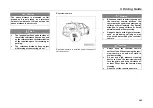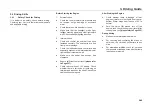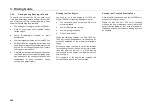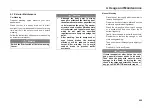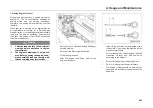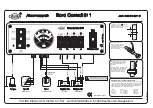
3. Driving Guide
3.6.4
Efficient Use of the Car
●
Maintain sufficient tire pressure because
insufficient pressure leads to wear of tire and
waste of fuel.
Please refer to Page 384
for
tire pressure parameters.
●
Make sure wheels are accurately positioned.
Inaccurate positioning makes the tires wear
out faster, increases engine load and wastes
fuel.
●
Do not make your car under over-load.
Excessive weight increases engine load,
wasting fuel.
●
Accelerate slowly and steadily. Avoid
emergency starting. It is better to use the
high gears during driving.
●
Avoid areas with dense traffic or traffic jam
as much as possible to prevent continuous
acceleration and deceleration, because stop-
and-go driving mode wastes fuel.
●
Avoid unnecessary parking and braking and
keep a stable speed. Driving according to
traffic signals help avoid frequent stop. Or
choose thoroughfares without traffic lights.
Keep appropriate distances with other cars to
avoid emergency braking. This helps reduce
brake wear.
●
Do not rest your foot on the brake pedal. This
causes early wear or overheating of braking
pad and fuel waste.
●
Avoid hitting road shoulder while driving.
Slow down when driving on uneven roads.
●
Avoiding mud or other foreign matters stuck
on chassis helps reduce car weight and
prevent corrosion.
●
Regularly maintain your car to keep it in its
best working condition. Dirty air filter,
unclean spark plugs, polluted engine oil and
grease will weaken engine performance and
waste fuel. To extend the service life of all
components and reduce operating costs, be
sure to perform regular maintenance.
Maintain your car more frequently if you often
drive under bad conditions.
Fuel-saving Driving
Fuel-saving driving can not only save fuel but also
protect environment.
●
Drive slowly for several minutes after starting
at low temperature, and then accelerate after
the engine warms.
●
Unload unnecessary items before driving.
●
Keep proper tire pressure.
●
Try to drive on good roads.
●
Avoid rapid acceleration. Step on the
accelerator pedal gently. Do not step on
pedals hard for start or stop.
●
Do not open windows when driving at high
speed.
●
Use the AC, audio system and other devices
properly.
●
Turn off all unnecessary electric appliances.
●
Shut off the engine for long-time parking and
prevent it from long-time running at idle
speed.
●
Drive on flat roads at economic speed.
●
Always drive in an appropriate gear based on
the running speed. Do not drive at high speed
in low gear.
●
Perform regular maintenance according to
instructions.
250








